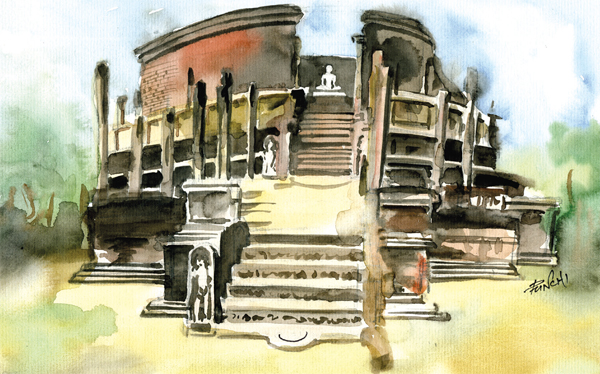The services of King Parakramabahu the Great
by Husna Inayathullah
Parakramabahu was the king of Dakkhinadesa. His objective for
Dakkhinadesa was to expand it so that it would surpass the greatness of
other kingdoms in a short period of time. He started a huge program of
construction and renovation, the remnants of which can still be seen in
central Sri Lanka today. It is mentioned of him as having restored an
ancient causeway called the Kotabaddha, over the Deduru Oya near modern
Kurunegala.
He ordered the construction of canals and dams and cleared a large
area of forest around them for new fields. Most notably, he built the
Parakrama Samudra, a giant reservoir from which a large swathe of
territory derived its water supply. On islands in the middle of the
reservoir he built a palace and a dagoba. He transformed the royal
court, making it a hub of cultural activity, attracting young nobles
skilled in various arts such as riding elephants or horses,
swordsmanship, in the use of foreign tongues and in dance and song. He
reformed the government of Dakkhinadesa, creating two ministries. They
were the military affairs and the internal administration to which he
later added a third department which oversaw the management of mines.
 |
|
The Vatadage in Polonnaruwa. |
Trade
Trade was an important component of Dakkhinadesa's income since the
island of Sri Lanka, given its geographical position, had always been at
the junction of several major trade routes. Chinese silk was a
significant import and was used in the consecration of statues and
shrines.
Pearls and gems constituted an important part of the island's
exports, as did cinnamon. Most trade was carried out through the main
seaports of the principality, Kalpitiya, Halaavatha (Chilaw) and
Colombo.
Parakramabahu I established himself at Polonnaruwa in 1153 and ruled
over the entirety of Sri Lanka for 33years according to Chulavamsa.
During this time he undertook much of the work he is best remembered
for, most significantly in the areas of religious reform, construction
and war.
Following the crushing of Queen Sugala's rebellion in
1157,Parakramabahu had the Tooth Relic and the Alms Bowl Relic brought
to Polonnaruwa.
The former was placed inside a jewel in the Temple of the Sacred
Tooth Relic in Polonnaruwa. Such constructions became a hallmark of
Parakramabahu's reign; his buildings for the sangha are described in
great detail in the Culavamsa and comprise an impressive body of work,
often accompanied with inscriptions stating his intentions and
accomplishments, such as at the Gal Vihare.
Restoration One of Parakramabahu's first projects was the restoration
of Anuradhapura, the ancient capital of Sri Lankan Kings which had been
destroyed by the Chola army, including the restoration of Thuparamaya,
Mihintale, and Ruwanweliseya. Then, having founded an administrative
centre called Parakramapura, he turned his attention on Polonnaruwa. Due
to the near-year sieges, the city had suffered and had reached a state
that nothing but its name remained. It is perhaps because of this that
so little of pre-12th century Polonnaruwa remains today.The king
initially divided the city into four districts or suburbs, each marked
with its own alms-giving house for the clergy,containing "vessels of
bronze, cushions and pillows, mats,carpets and bedsteads". He ordered
the construction of hospitals, which he visited on several occasions.
Gardens
He also expanded Polonnaruwa's city walls, constructing an elaborate
three-walled complex featuring turrets for archers and 14gates, none of
which has survived till modern times. Beyond the city precinct it is
believed he built or renovated three smaller townships, in addition to
Parakramapura - Rajavesi Bhujanga, RajaKulantaka (Sinhapura) and
Vijitapura. Extensive gardens were also laid down around
Polonnaruwa,featuring ponds and bathing-pools, one of which, the Twin
Pools,survives to this date. The 'Island Garden', extended into the
middle of Thopa Wewa on a promontory.
Much else survives, such as the Gal Vihare, or "Stone Shrine"near
Polonnaruwa. The Culavamsa attributes the monument in its entirety to
Parakramabahu, though in truth his contribution may have been extensive
refurbishment. The Vatadage or "Circular Temple",was built around 1157
following the suppression of Queen Sugala's revolt in Ruhuna, to host
the recently recovered Sacred Tooth Relic and Alms Bowl Relic.
The Lankatilaka Temple, Alahena Pirivena, Jetavanarama and the Demala
Maha Cetiya were also built during his reign. At the centre of
Polonnaruwa Parakramabahu expanded and beatified the royal palace.Little
of it remains today, but its soaring walls hint at the grand scale of
the king's vision. Gal Vihare features three statues of the Buddha in
three different poses carved from the same large rock.
Renovation
Parakramabahu also continued his program of hydraulic works begun in
Dakkhinadesa, including the renovation and reconstruction of reservoirs
and canals wrecked during the Chola invasion. Inscriptions detailing his
work can be found at the Maha Wewa near Uruwela, Padaviya Wewa and Panda
Wewa in North-Western Province.
In all, Parakramabahu is said to have restored or built over 216
reservoirs and tanks. Despite their magnificence, Parakramabahu's works
exacted a heavy toll on the populace and the treasury. For much of the
work in Anuradhapura he utilised Tamil prisoners of war seized during
the Pandyan War. Nevertheless, taxation and Rajakariya (a feudal system
in which work was owed to the king by commoners) contributed in large
part to the projects. An interesting indicator of the burdenof taxation
is the disappearance of larger gold coins towards the end of
Parakramabahu's reign.
The popularity of Parakramabahu is attested by the fact that no less
than seven monarchs adopted his name over the next four centuries, of
whom only two or three could lay claim to even a fraction of his
successes. |

